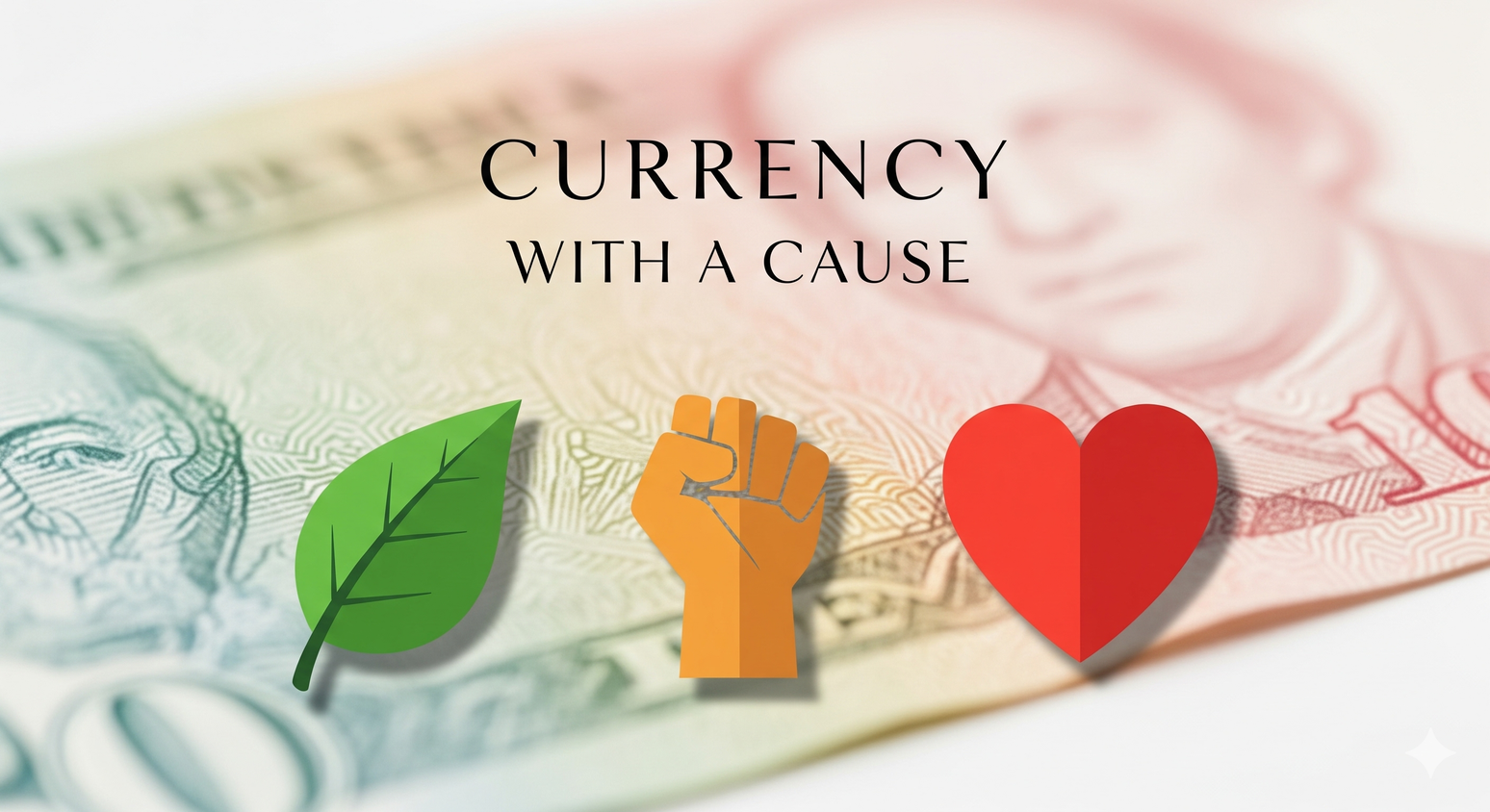Paper, Polymer, and Progress: A Global Study of Purpose-Driven Currency
I. Executive Summary: Currency as a Medium for Change
Physical currency, for centuries a mere facilitator of trade, has undergone a profound evolution. This report documents how banknotes and coins have transcended their traditional role to become powerful platforms for public discourse, historical commemoration, and social advocacy. Through a detailed analysis of case studies from around the world, this study explores the intricate motivations and mechanisms behind the issuance of purpose-driven currency. The investigation reveals that currency design is no longer a private matter for political elites but is increasingly influenced by grassroots movements and public consultation. The analysis finds that the concept of "environmental" currency exists in a duality: notes that bear a conservation message and those that are themselves manufactured sustainably. The debate between paper and polymer is shown to be more nuanced than a simple binary choice, encompassing a holistic view of the cash lifecycle from production to disposal. Additionally, the report illustrates how commemorative notes are not just symbolic; they are a direct mechanism for fundraising, sold at a premium to leverage their collectible value for charitable causes. Ultimately, the power of these banknotes lies not just in their imagery but in the stories they tell, serving as a testament to social progress, democratic expression, and the ongoing struggle for equality.
II. Introduction: The Art and Ideology of Numismatics
This report delves into a specific and evolving category of numismatics: banknotes and coins that go beyond traditional themes of heads of state and national monuments to actively champion specific social, political, or environmental causes. The investigation aims to uncover the historical context, the intricate design processes, the key people and organizations involved, and the public's reception to these tangible statements of a nation's values. Historically, currency has always served as a physical representation of a nation's identity, history, and aspirations.
The United States dollar, for example, carries symbolism rooted in the very ideals of its founding. The Great Seal of the United States, prominently featured on the one-dollar note, was the result of a concerted effort by figures such as Benjamin Franklin, Thomas Jefferson, and John Adams to create a symbol for the new nation.
III. The Green Treasury: Banknotes for Environmental Stewardship
The intersection of currency and environmentalism manifests in two distinct but related ways: through the imagery and message on the notes and through the very materials and processes used to produce them. The concept of an environmentally friendly banknote is a complex one, involving a complete re-evaluation of the entire cash lifecycle.
The Sustainability of Money Itself
The debate over the environmental impact of paper versus polymer banknotes is a multifaceted discussion. Proponents of polymer currency, such as the Bank of Canada and the Bank of England, point to extensive life-cycle assessments that have found polymer notes to be more sustainable in a number of key areas.
However, the banknote industry is not static, and significant efforts have been made to increase the sustainability of traditional paper currency. The European Central Bank has committed to a progressive shift, mandating that all euro banknotes will be produced entirely from sustainably sourced cotton by 2023.
Celebrating and Protecting Our Natural World
Beyond a note's physical composition, its design can serve as a powerful tool for environmental advocacy. While many currencies feature animals for national symbolism, others highlight endangered or culturally significant species to raise awareness. A 1791 penny from Sierra Leone, for instance, featured the West African lion, a species genetically distinct from others.
A truly pioneering approach to environmental currency is seen in the limited-edition 10-tala note issued by Samoa. This note, released to commemorate the 2019 Pacific Games, was touted as the world's first carbon-neutral banknote.
The discourse on currency and conservation extends even into the realm of speculative future technologies. The concept of "interspecies money," or a central bank digital currency (CBDC) that could be held by nonhuman life-forms, has been proposed as a radical new model for conservation finance.
IV. Echoes of History: Currency Commemorating Social and Political Movements
Beyond environmental causes, currency has become a powerful medium for commemorating pivotal moments in social and political history. Notes and coins have been used to honor those who fought for human rights, civil liberty, and equality, transforming national currency into a tangible record of progress.
The March of Equality: Honoring Women's Suffrage
New Zealand was a global pioneer in the fight for gender equality, becoming the first self-governing country to grant women the right to vote in 1893.
In the United States, a more public and contentious process unfolded. The "Women on 20s" grassroots movement gathered over 600,000 online votes to advocate for placing a woman on the twenty-dollar bill.
The Unfinished Journey: Civil Rights and Social Justice
Canada's new vertical ten-dollar note provides another compelling example of currency as a vehicle for social justice. The note features Viola Desmond, a Black Nova Scotian businesswoman who, in 1946, was jailed for defying racial segregation in a movie theater.
In a similar vein, the United States Mint honored the 50th anniversary of the Civil Rights Act of 1964 with a commemorative silver dollar.
As a crucial historical counterpoint to these modern civil rights affirmations, the report must acknowledge the use of currency to glorify oppression. During the Civil War, Confederate currency was a powerful propaganda tool, featuring images of enslaved laborers working in fields to legitimize and reinforce the institution of slavery.
Money for a Mission: The Currency of Charity
In a unique application of numismatics, some central banks and issuing authorities have leveraged the collectible nature of commemorative notes for philanthropic purposes. This fundraising model involves selling legal tender notes at a significant premium above their face value, with the proceeds dedicated to a charitable cause. A notable example is the Bank of China (Hong Kong)'s issuance of commemorative notes for the 2008 Beijing Olympic Games.
This fundraising model has been applied to other high-profile events. The Bank of England, for example, held a series of charity auctions for the new King Charles III banknotes.
V. The Forge of Design: The Process and People Behind the Scenes
The issuance of a new banknote is a complex, multi-stakeholder process that goes far beyond simple artistic rendering. While security remains the primary driver for redesigns, the inclusion of social and political themes has fundamentally changed who is involved in the process and how it is carried out.
From Concept to Circulation
In many countries, the currency design process is a highly technical and secretive undertaking led by government bodies. In the U.S., for instance, the Bureau of Engraving and Printing works with a committee of stakeholders from the Treasury and the Secret Service to ensure that new notes are resistant to increasingly sophisticated counterfeiting attacks.
However, there is a clear and developing trend towards incorporating public input into this once-private process. The U.S. Treasury's response to the "Women on 20s" movement was an unprecedented public engagement campaign, with the department receiving over a million submissions from citizens, including many from children.
At the heart of this process is the bank note designer, a highly specialized professional who blends artistic talent with a deep understanding of advanced security technologies.
Public Opinion and Cultural Significance
The release of a new banknote, particularly one with a purpose-driven theme, can elicit a wide range of public reactions. The U.S. redesigns were largely lauded for their historic significance and for legitimizing the "power of protest" by reframing national monuments as key sites of dissent.
However, the introduction of new currency is not without its challenges and criticisms. The public reaction to the U.S. Susan B. Anthony coin was tepid, as the public confused it with a quarter, leading to a lack of popular use.
This nuanced range of reactions demonstrates that the process of currency redesign is no longer a top-down edict but a complex negotiation between government institutions, private industry, and the public. The U.S. experience in particular illustrates a direct connection between a well-organized grassroots movement and a fundamental shift in a government's approach to an otherwise staid and secretive process.
VI. Conclusion: The Future of Currency as a Cultural Artifact
The detailed analysis presented in this report confirms a central thesis: currency has evolved beyond its function as a financial instrument to become a powerful and dynamic cultural artifact. Its physical form can be a canvas for a nation's values, a vehicle for historical memory, a tool for social activism, and even a mechanism for philanthropy.
The findings demonstrate that modern currency design is a complex and often contentious process. The push to honor social justice movements and re-evaluate historical figures is not a purely aesthetic choice but a direct result of public will and grassroots campaigns. At the same time, the industry is grappling with fundamental questions about its own environmental footprint, leading to the development of new materials and production models that aim for a holistic reduction in environmental impact.
In an increasingly digital world, the future of physical currency is a subject of intense debate. The rise of digital payments and the discussion of central bank digital currencies present a challenge to the traditional role of cash. However, as physical money becomes less about everyday transactions and more about cultural statements, its symbolic role may, in fact, become more significant. The existence of radical, forward-thinking concepts like "interspecies money" demonstrates that even in a digital future, the fundamental idea of using currency to represent and drive social, political, or environmental progress remains a potent and relevant vision. In this light, the banknotes and coins examined in this report are not just financial objects; they are tangible testaments to the power of human ingenuity and our ongoing aspiration for a more just, equal, and sustainable world.
Explore Popular Articles
The Possible Future of Venezuela's Current Economic Crisis
Venezuela at a Crossroads Economic Possibilities After the Capture of Nicolás Maduro In a move that...
The End of a Corrupt Narco-Regime in Venezuela: The Venezuelan Pivot (2026)
The Venezuelan Pivot (2026) Geopolitical Shock, Monetary Reconstruction, and the Asymmetric Value P...
More Than Money: The Tangible Assets Drawing a New Crowd
The New Golden Age of Collecting A Market Transformed by Youth, Technology, and Value For decades,...




